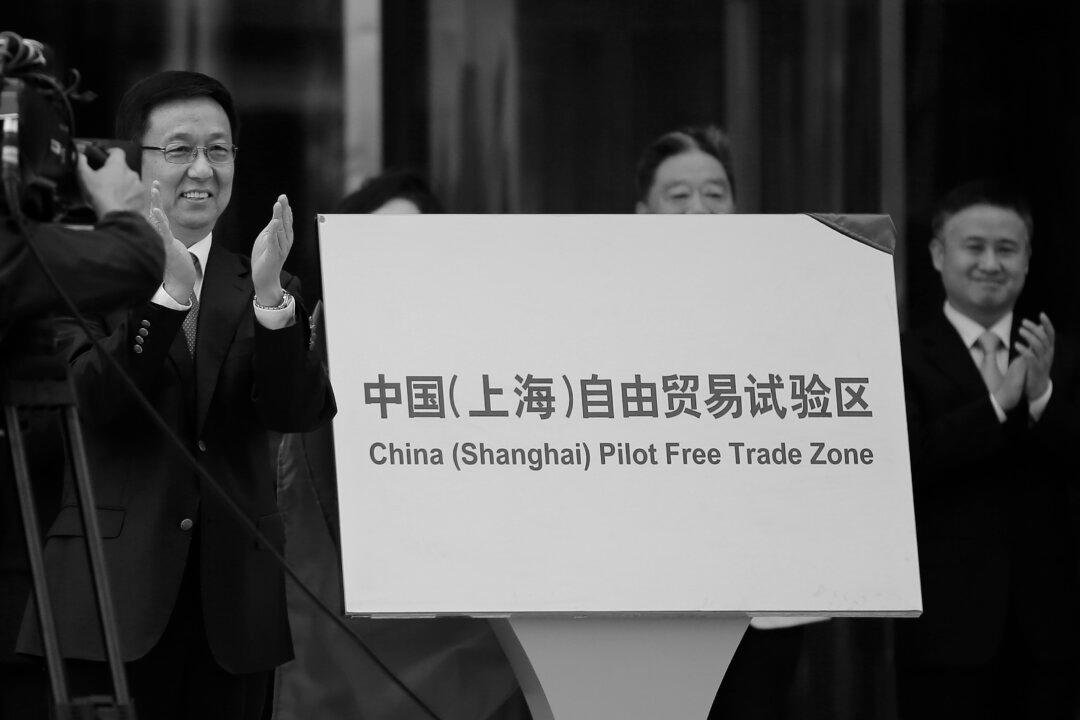Many people had unrealistic high expectations for “reform” following the Chinese Communist Party’s 18th National Congress last November. In reality, no practical measures of economic reform have even been proposed yet.
Recently, the Shanghai Free Trade Zone has been heavily promoted, and it has seemingly become a beacon for initiating economic reform. In fact, the Shanghai Free Trade Zone has nothing to do with any kind of economic reform—it is merely a utopian experiment.
The idea of the Shanghai Free Trade Zone was proposed years ago. In 2009, the China Association of Productivity Promotion Center submitted the idea of China “establishing a free trade zone at Pudong” to the then Chinese Premier Wen Jiabao.
Later, the National Development and Reform Commission (NDRC), the State Development Research Center and many other departments began on-site research on the feasibility of establishing a free trade zone at Pudong, Shanghai.
On July 3, 2013, the Standing Committee of the State Council passed the overall plan for the “China (Shanghai) Free Trade Pilot Zone.” One month later, the State Council gave its stamp of approval.
Over the past few months, current Chinese Premier Li Keqiang has been described as someone with a strong political will and determination, and likened to a bulldozer that cannot be stopped.
The current proposed Shanghai Free Trade Zone includes 4 Special Customs Surveillance Zones—the Yangshan Bonded Port Zone, Shanghai Pudong Airport Bonded Zone, Waigaoqiao Bonded Zone, and Waigaoqiao Bonded Logistic Park—with a total area of almost 18 square miles.
According to media reports, the free trade zone will involve reforms in the areas of investment, commerce, finance, and administrative law. More specifically, marketization of finance and interest rates will be the focal point within the trade zone, which will be coupled with marketization of asset pricing by financial institutions, convertibility of capital accounts in Chinese yuan, establishment of foreign banks by foreign financial institutions that have received approval, and offshore financial services.
The Shanghai Free Trade Zone could turn out to be the first area in China where free exchange of the Chinese yuan is possible. A monument showing how committed the Chinese state is to economic reform would eventually be erected here. If everything went well with the Shanghai Free Trade Zone, this would become a new platform for doing business with various countries, raising economic growth to new heights and upgrading the Chinese economy.
In addition, the State Council has stated that the “Shanghai Free Trade Pilot Zone” could be both “replicated and promoted”—the Shanghai Free Trade Zone would eventually expand to the entire Pudong New Area, totaling 752 square miles. Not only that, Guangdong and Tianjin Provinces have proposed their own plans for free trade zones.
In fact, the idea of a free trade zone was not created by the Chinese. According to incomplete statistics, there are over 1,200 free trade zones in the world, of which 425 are located in 15 developed countries, accounting for approximately 35.4 percent, and 775 are located in 67 developing countries, totaling around 65.6 percent.
In the 20th century in the United States, from the late 1960s to the early 1970s, different states within the United States began setting up foreign trade zones. In 1980, there were 77 free trade zones. The number reached 199 at the end of 1994. There were 285 free trade subzones, with the total number of free trade zones topping 484.
Comparing the first free zone set up by China and the free trade zones around the world, one main difference is that China until now has not had a real market economy. The free trade zone in China is initiated and led by the state, whereas the free trade zones around the world are based on a market economy and led by companies.
A second difference: China would like to test the idea of liberation of its Chinese currency, the yuan, while the free trade zones around the world are built on the prerequisite of liberated currency.
What’s more important, the very existence and development of free trade zones in major countries around the world are not in conflict with either the economic system or the political system of the host country in which the free trade zone is established.
However, in China, the Shanghai Free Trade Zone faces resistance coming from both the political system and party ideology. The soon to be listed Shanghai Free Trade zone is predestined to face one of the two following scenarios.
Either the Shanghai Free Trade zone would create a domino effect, spearheading a liberal reform of economic systems in greater Shanghai, Shenzhen, and the Yangtze River Delta region.
Or the socioeconomic gap would continue to exist within and without the free trade zone, resulting in an isolated island with a unique economic policy.
The first scenario is very unlikely to happen considering the current situation in China. The present political environment won’t encourage the growth of a free economy.
With any hint of political reform now being put on the backburner, regression of political ideology, denial of any possibility of adapting constitutionalism or developing a civil society, the free trade zone with the goal of economic liberation would surely be only a utopian experiment.
“Replicable and promoted” is just a pipe-dream. Simply put, the Chinese regime will never allow a liberalized economy to take root, as this would eventually lead to political and ideological freedom, collapsing the foundation of one-party authoritarian rule.
Copyright © 1998-2013, RFA. Used with the permission of Radio Free Asia
Written in English by Christine Ford.
Read the original Chinese article.
